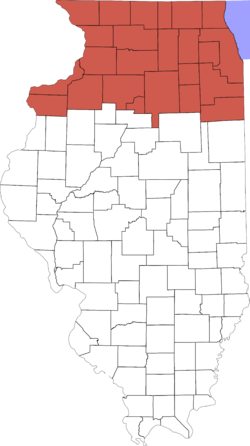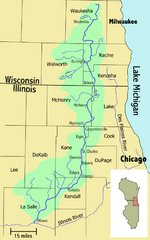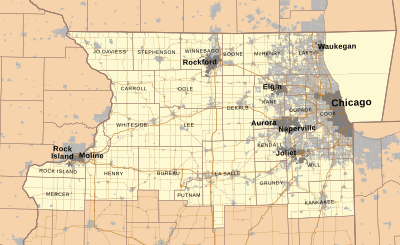Northern Illinois facts for kids
Quick facts for kids
Northern Illinois
|
|
|---|---|

Chicago, Illinois
|
|

Counties that are colored red are considered a part of the Northern Illinois region.
|
|
| Country | |
| State | |
| Largest city | Chicago |
| Population | 9.7 million |
Northern Illinois is a large area in the northern part of the U.S. state of Illinois. It covers about one-third of the state. This region is home to most of Illinois's people, with almost 9.7 million residents as of 2010. It includes big cities like Chicago, Rockford, and the Quad Cities.
Contents
Economy and Jobs in Northern Illinois
Northern Illinois is a very busy place for business. It includes the big cities of Chicago, the Quad Cities, and Rockford. These areas have over 75% of Illinois's people and most of its economic activity. Many large companies, including some of the biggest in the world (Fortune 500), are here.
The economy in this region focuses on making things (manufacturing), buying and selling goods (commercial and retail), and providing services. Important business centers include the Chicago Loop and special areas for technology and research. Even though there are many cities, some parts of Northern Illinois are also great for farming. These areas are part of the Corn Belt, where lots of corn is grown. The company John Deere, famous for farm equipment, has its main office in Moline.
Smaller cities like Kankakee, LaSalle-Peru, and Ottawa also have strong manufacturing and farming economies. Northern Illinois is also a major hub for trains and trucks, making it one of the busiest places for freight transport in the world.
Major Roads and Travel
Interstate 80: A Southern Border
Interstate 80 is a major highway that sometimes acts as an unofficial southern border for Northern Illinois. You might hear it mentioned in weather reports, like "south of Interstate 80 will get rain, but north of Interstate 80 will see snow." This helps people understand where different weather will happen.
Interstate 88: Connecting East to West
Interstate 88, also known as the Ronald Reagan Memorial Tollway, connects the region from east to west. It stretches from the Quad Cities through towns like Sterling-Rock Falls, Dixon, DeKalb, Aurora, and Naperville, all the way to Chicago.
Northern Illinois is the only part of the state with toll roads. These roads require a small fee to use them. The Illinois State Toll Highway Authority manages these tollways. This is another way Northern Illinois is different from Central and Southern Illinois.
Learning and Universities
Northern Illinois is home to many important schools and universities.
Northern Illinois University (NIU) in DeKalb is right in the middle of the region. It is the second-largest public university in Illinois. This university helps many students in the northern counties of Illinois.
The Chicago area has several big colleges. The University of Illinois at Chicago is the third-largest state school. Other famous schools include the University of Chicago and Northwestern University. Many other great schools are also in the area, like the Illinois Institute of Technology, Loyola University, and DePaul University.
Smaller liberal arts colleges are also found around Chicago, such as Aurora University and Wheaton College. In Rockford, you can find Rockford University and branches of other universities. The Quad Cities area also has colleges like Western Illinois University-Quad Cities and Augustana College.
These schools make Northern Illinois a strong center for research. Important scientific discoveries, like those related to the Atomic Bomb and the Fujita Scale (which measures tornado strength), have roots in institutions here.
Culture and Fun
The culture in Northern Illinois is strongly connected to Chicago. Most people in this region support Chicago's sports teams. They also tend to follow Chicago's news and media. The main college football team in Northern Illinois is the NIU Huskies. Many fans also cheer for the Illinois Fighting Illini, Notre Dame Fighting Irish, and Northwestern Wildcats.
Professional sports teams from Chicago are also very popular. These include the Sox (baseball), Cubs (baseball), Bears (football), Blackhawks (hockey), and Bulls (basketball). In other parts of Illinois, like Central and Southern Illinois, people often support teams from St. Louis.
People in Northern Illinois might speak with different accents depending on where they live. For example, someone from the Chicago area might have a typical "Chicago dialect." People living further west, closer to Iowa, might have a more general "Midwestern" accent. The culture and media in each county often depend on how close it is to a major city. For example, areas near Ottawa mix cultures from Chicago, the Quad Cities, and Peoria.
Parts of Northern Illinois
Northern Illinois can be divided into smaller areas.
Chicago Metropolitan Area
The Chicago metropolitan area, often called Chicagoland, is the big area around the city of Chicago and its suburbs. This region is connected to Chicago through its geography, people, economy, and culture.
Chicago: The Big City
Chicago is the third-largest city in the United States, after New York City and Los Angeles. It has about 2.7 million residents and is the biggest city in Illinois and the American Midwest. The larger Chicago metropolitan area is home to 9.5 million people, making it the third-largest in the U.S. Chicago is the main city of Cook County, though a small part extends into DuPage County.
Collar Counties: Neighbors of Chicago
The "collar counties" are the five counties that touch Chicago's Cook County. These counties are DuPage, Kane, Lake, McHenry, and Will. They are strongly connected to Chicago economically. These suburban areas have different political views than the city itself. Chicago has traditionally supported the Democratic Party, while the collar counties have often supported the Republican Party.
Fox Valley: Along the River
The Fox Valley, also known as the Fox River Valley, is a suburban area along the western edge of the Chicago suburbs. This region is centered around the Fox River, which flows through Illinois and Wisconsin. About 1 million people live here. Native American tribes like the Potawatomi, Sac, and Fox once lived near this river. Some cities in the Fox River Valley, like Aurora and Elgin, were once big manufacturing centers. Aurora is the second-largest city in Illinois. Nearby cities like Batavia, St. Charles, and Geneva are known as the "Tri-City area."
Northwestern Illinois
Northwestern Illinois generally includes counties like Jo Daviess, Carroll, Whiteside, Stephenson, Winnebago, Ogle, and Lee. This part of Illinois borders Iowa to the west and Wisconsin to the north.
Rockford Metropolitan Area
The Rockford Metropolitan Statistical Area is an area that includes four counties in north-central Illinois. The city of Rockford is the main city in this area. In 2010, about 349,431 people lived in this metropolitan area.
Quad Cities: Five Cities on the River
The Quad Cities is a group of five cities located on the Mississippi River. They are on the border between Iowa and Illinois. The cities are Davenport and Bettendorf in Iowa, and Rock Island, Moline, and East Moline in Illinois.
These cities form the center of the Quad Cities Metropolitan Area. In 2012, this area had about 382,630 people. The Quad Cities are located about halfway between Minneapolis and St. Louis, and between Chicago and Des Moines. It is the largest market within 300 miles west of Chicago.
Counties of Northern Illinois



